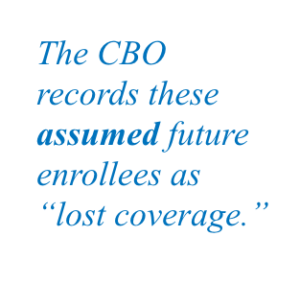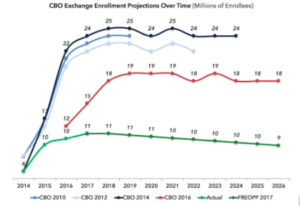What Still Matters – Behind the Health Care Headlines
By The Policy Circle Team
Where can a conversation possibly go when someone tells you that a new health care reform plan is going to take health coverage away from 22 million people? With the Congressional Budget Office (CBO) backing that claim…surely that is a showstopper.
Not so fast.
Along with educated guesses that the housing market would never crash and that all children will be potty-trained by the age of three, CBO analysis has a robust history of making imperfect assumptions about human behavior.
Four key facts lurk behind the CBO estimate that 22 million people will lose insurance:
- The CBO is taking a baseline it estimated in 2016, and calculating future behavior from that baseline.
- The CBO previously overestimated by 13 million the number of health care participants in the Obamacare exchanges in 2016 (FactCheck.org).
- The CBO also underestimated by more than 4 million the number of health care participants that would be enrolled in Medicaid in 2016 (FactCheck.org).
- Recent CBO projections of future enrollment start from a new 2016 baseline but continue aggressive assumptions of how Americans would respond to a health care mandate and the future behavior of individual states. The CBO assumes 16 million Americans will choose to go uninsured in 2019 if the healthcare mandate is removed AND that more states will decide to expand Medicaid eligibility, so 5 million Americans would be impacted by changing that future coverage option.
Thus, the CBO records these assumed future enrollees as “lost coverage.” The key point being – a large amount of these individuals were not yet covered, and if what’s past is prologue, were not headed toward coverage under Obamacare. And the number of people who decide not to enroll again because it is no longer mandated, speaks volumes about the quality and value of the coverage.
What is the CBO?
The Congressional Budget Office’s job is to “score” the impact of legislation, such as the new American Health Coverage Act proposed to replace the Obama Administration’s Affordable Care Act. It assesses legislation across a 10-year timeframe. The CBO is restricted by its scoring rules and relies upon certain assumptions like behavioral effects to quantify the impact of the legislation – economic and otherwise.
While the CBO was created by Congress to “provide objective, impartial information about budgetary and economic issues,” their analysis has not been flawless because their work requires educated assumptions of behavioral effects. (CBO.gov) In the case of healthcare reform, the two biggest assumptions underlying their projections are: 1.) How will Americans react to a mandate? and 2.) What will be the future behavior of states?
AEI scholar, James Capretta weighs in, saying:
” ‘I am a big fan of CBO in general, that doesn’t mean that they get everything right. In the healthcare arena I think they have done a couple things that are probably skewing the estimates.’
‘One is they are working off a very old baseline..from over a year ago. They’re assuming a lot more enrollment in Medicaid in the future than would occur, and also in the exchanges than would occur. Which makes the coverage numbers look worse than they really will be in actuality….’
‘Secondly, they believe really heavily in the individual mandate. I believe it does have some effect, but probably not as much as CBO thinks.’ ”
Three assumptions that require another look:
- The CBO has a history of overestimating the number of people who will enroll in Obamacare,
- CBO assumptions vastly overestimate how the American people respond to a federal mandate to buy insurance, as demonstrated by IRS data, and
- The CBO projects that more states will expand Medicaid, while competing analysis projects minimal additional expansion.
Scholar Avik Roy’s analysis, explained below, finds that these factors could mean CBO’s analysis is off by as much as 19 million people who would not actually be losing health coverage.
- Estimating Coverage: In the current debate, many policy experts question the baseline estimates that have been published. If your starting point is off, then everything is off.
Roy states that the CBO has overestimated the number of people who will sign-up for coverage in the Obamacare exchanges, including in its March 2016 baseline assessment (in red below). His chart maps the projected vs. real enrollment.

So, Roy concludes, The March 2016 “baseline is off by 7 to 8 million in future exchange enrollment; hence, the impact of the AHCA is also off by the same amount.”
- Estimating impact of a mandate: The CBO projects that mandating people to buy health insurance will drive people to buy insurance. It first estimated that including a “mandate” would increase the number of covered individuals by 16 million – but that didn’t happen. Avik Roy explains: Now, with the mandate on the chopping block, the “CBO… believes that, due to the AHCA’s repeal of the individual mandate, 14 million people would choose to go uninsured in 2018, and 16 million in 2019.”
Those estimates are called into question because Obamacare supporters and the IRS have found the mandate does not have the behavioral impact assumed by the CBO.
“…Jonathan Gruber—one of the law’s most famous advocates—believes Obamacare’s individual mandate is having little effect. In a 2016 article for the New England Journal of Medicine, Gruber and two co-authors wrote, ‘When we assessed the mandate’s detailed provisions, which include income-based penalties for lacking coverage and various specific exemptions from those penalties, we did not find that overall coverage rates responded to these aspects of the law.’ (Emphasis added.)”
IRS data also shows that:
“The penalty has not motivated the vast majority of the uninsured to buy coverage. The IRS Commissioner earlier this year reported to Congress on the efficacy of the individual mandate for the 2015 tax year. Here’s what he reported:
- 6.5 million uninsured people paid the penalty;
- 12.7 million uninsured people – nearly twice as many – got an exemption from the penalty;
- 4.2 million people ignored the penalty – they simply left the line on the tax form blank; the IRS processed their returns and mailed them their refund checks.”
- “That is a total of 23.4 million uninsured people” who were not incentivized by the mandate. (Galen Institute)
- Estimated State Behavior regarding Medicaid: “A key part of the CBO’s March 2016 baseline is an assumption that most of the states that have yet to expand Medicaid under Obamacare will soon do so. Hence, the House GOP plan will reduce coverage by 5 million people in the future, from states that have yet to expand Medicaid.” (Avik Roy, Forbes)
Additional analysis, however, suggests that not as many new states will expand their Medicaid coverage because they continue to fear “exposing their taxpayers to significant and growing liabilities that the federal government may back away from over time.”
What does this mean?
Avik Roy concludes the first CBO estimate of AHCA impact on coverage could be off by up to 19 million due to a flawed baseline that overcounts state Medicaid expansions and the influence of a mandate. Nineteen million is not a small rounding error or slight difference in analysis when the headlines from the CBO’s assessment are that 22 or 23 million Americans could be negatively impacted.
Conclusions
- We are flawed humans who produce a lot of flawed estimates based on flawed human behavior.
- Unfortunately many find it easier to predict the impact of a “mandate” on human behavior than to predict the impact of free market competition.
- Be careful about blindly believing the statistics you read, without first figuring out who is assuming what to draw their conclusions.
Challenge
Check in with your elected officials and see how they explain the CBO projections.
Resources
- How Does Congressional Budget Office Scoring Work? A conversation with a former director of the agency on the American Health Care Act vote and how health-care legislation is appraised by the federal government The Atlantic, May 4, 2017
- CBO’s Obamacare Predictions: How Accurate? FactCheck.org, March 13, 2017
- Believe it or not, CBO score of House GOP Obamacare Replacement is better than expected Forbes, March 14, 2017
- How to Read an ObamaCare Prediction, Congress’s fiscal scorekeepers are often wrong but never more modest. WSJ May 24, 2017
- CBO Is Wrong And Its Numbers Shouldn’t Deter Needed Reform, Forbes May 26, 2017
- And here you can click to read The Policy Circle’s Brief on Healthcare Reform, and The Policy Circle’s Healthcare 2016: Obamacare and the State of Healthcare
Byline: Kristin Jackson is a middle-of-America native with a decade of experience working on policy in our nation’s capital. She serves as policy editor for The Policy Circle. For Kristin’s biography, click here.